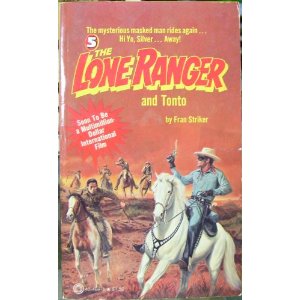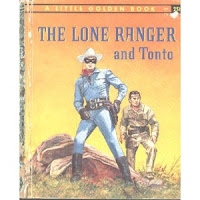With the new Lone Ranger movie coming out in a few days, it seems only fitting we explore the character a bit (for all you die-hards who already know who The Lone Ranger is).
A total of 18 Lone Ranger novels were published through Grosset & Dunlap and over the past five years I have been reading one every so often. The prose is excellent and flows so smoothly that I find myself reading about two or three a year -- spreading them out to enjoy them as long as I can. The fifth novel, The Lone Ranger and Tonto, was published in 1940. The plot can be summed up in one paragraph.
Dave Walters is falsely accused of robbery and The Lone Ranger breaks the youth out of jail. While Tonto keeps the boy hidden from the posse, The Lone Ranger learns the identity of the guilty party -- Steve Delaney. A gambler by trade, Delaney owns most of the mortgages in town, making him a very powerful man in Snake River. Alone in Delaney’s private residence, The Lone Ranger ties, bounds and gags the gambler so the Masked Man can remove his mask and use his makeup kit to impersonate the crook. While masquerading as Delaney, The Lone Ranger hopes to uncover enough facts to prove Walters’ innocence. While Tonto helps aid The Lone Ranger, the sheriff and his posse find Dave held up in a cave and brings the boy back to town. Upon their return, The Lone Ranger has uncovered enough evidence to prove Delaney stole the jewels from the old widow who was brutally murdered... not the innocent youth. Failing to throw the blame on Dave Walters, Delaney then attempts to double-cross his own comrades. Angry for the betrayal and hold-out of funds, the men reveal the truth of the murder and robbery to the sheriff. Dave Walters is reunited to his parents who he was seeking before stepping foot in Snake River.
 |
| 1979 paperback reprint of the G&S novel. |
This is the kind of plot you would expect to see in a Monogram Studios cowboy Western: The Trail Blazers, The Range Busters... heck, any of them would have used the same plot.
Notes About the Novel
The makeup kit was featured prominently in this novel as The Lone Ranger remained in disguise throughout most of the adventure, impersonating Delaney in an effort to thwart his scheme. His infiltration caused a number of people to confess details of the scheme in the hopes of seeing him reach the end of the rope -- a tactic employed often by The Green Hornet on the radio program. In disguising himself, the description of the makeup kit contents and the standard wear of the Ranger is described.
It took but an instant to remove the mask and hide it beneath his shirt. The Lone Ranger took a small bottle from a saddlebag and poured a few drops of fluid it contained into the palm of one hand. He replaced the bottle and rubbed his palms briskly together, then rubbed them over his face and neck. The fluid was a stain that Tonto made from roots. It darkened the Lone Ranger’s complexion by several degrees. He hung his white sombrero on the saddle horn and replaced it with a battered old black felt that had seen far better days. Next he changed his black silk neckerchief for one of brilliant hue. This was his disguise. It wasn’t much, but past experience had proved it to be all that was required.
In chapter two, titled “Dave’s Story,” more information about The Lone Ranger’s mask is provided.
Dave watched the masked man, wondering if he would sleep with the mask in place. He did not know that The Lone Ranger wore the mask, habitually, whether there was need of it or not. It has become a part of him, and because of that it did not hamper him in action.
The Lone Ranger sends a message on paper via horseback. Tonto receives the message and reads it clearly but Dave Walters is puzzled. In short stilted sentences, the Indian made Walters understand that The Lone Ranger’s message was a combination of the white man’s way of writing and the Indian’s picture writing. Many of the masked man’s thoughts and suggestions had been abbreviated in a way that only Tonto would understand. If anyone had intercepted the message it would have been totally without meaning. This unique form of communication was established in an early Lone Ranger radio broadcast from 1935, and verified by an inter-office memo between George W. Trendle and Fran Striker, who proposed this be used as a means of offering young children their own codes for exchanging communication. Perhaps a Lone Ranger ring was in the works?
The Lone Ranger’s silver bullets was explored twice in this novel. Once when Tonto makes reference that he received cash from a silver mine toward the North. There were silver-bearing claims in the country to the north and many of these claims had been on land controlled by Indians. As Striker explained in the novel, There were, at the time, instances where white men had made a deal with the Indians to work the land and sell the ore at ridiculously low prices. But those low prices represented vast wealth to the Indians.
In chapter 16, Dave Walters looks over The Lone Ranger and Tonto’s reserve supplies and finds extra blankets, countless cans of food, boxes of cartridges, clothing, saddle equipment, a couple of short rifles of the finest manufacture, a keg of gunpowder, a supply of rope, materials for re-shoeing the hoofs of the great horse Silver, and moulds for making The Lone Ranger’s silver bullets.
The Lone Ranger’s code of ethics was explored (as it was in many Lone Ranger novels). The masked man hesitated fighting a man that would bring about many crooks. It was a turn of events The Lone Ranger had not counted on. "The masked man hesitated. He did not like to attack from the rear. It would give him an unfair advantage…"
In chapter eight, The Lone Ranger attempts to frighten a confession from Steve Delaney. The gambler will not talk and when the Ranger threatens a number of consequences, the gambler calls his bluff. Here, The Lone Ranger found himself in a peculiar situation. It was against his code to use any of the familiar means of making an unwilling man talk. Even though Dave Walter’s life depended on what the gambler might reveal, the masked man found himself incapable of resorting to physical torture.
The Radio Program
The March 26, 1947 radio broadcast of The Lone Ranger, titled "Reward Notice," featured a character named Steve Delaney. Striker often did this many times on the radio program, reusing names of characters over the years. The June 17, 1940 radio broadcast titled, "Sheriff Olson," featured a character name Snake Walters. The name of the town in this novel is Snake River and the boy wanted by the posse was Dave Walters. There is a character in this novel called Lem Purvis. The May 2, 1938 radio broadcast titled, "Lem Purvis," features a character named Lem Purvis. Coincidence? No, Striker was simply reusing names from his radio scripts.
Additional Notes
There is another book of the same name, The Lone Ranger and Tonto, published for children (pictured here for your reference), known as A Little Golden Book, and is not to be confused with the novel described above.
The Lone Ranger and Tonto was based (expanded) from the second of eight Lone Ranger pulp magazines, The Masked Rider's Justice (May 1937). All eight of the pulp magazines have been reprinted (twice, courtesy of two different publishing companies). Five of the eight pulps were made into Lone Ranger novels for G&S, elements were borrowed from a sixth for another novel. But I personally recommend the actual novels as there's more material to enjoy.


